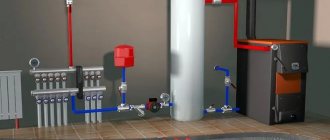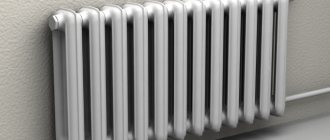When designing a country cottage, several engineering systems are laid out to provide the owners with the benefits of civilization. The issue that concerns everyone is comfort in their own home, which is difficult to imagine without stable operation of the heating system.
In urban conditions, home heating is carried out in two ways, using central or autonomous (local) heating. For the vast majority of owners of suburban areas, only the second option is available, and all they need to do is choose the optimal method of heating their home. Heating can be carried out in different ways, the most common of which is gas heating of a private house.
We asked specialists from the Miralex store, which offers a wide range of heating boilers, to tell us how to understand the characteristics of boilers.
Gas boilers are easy to operate and maintain Source my-teplo.ru
Features of water heating: system requirements
The dominance of water heating in the private sector is explained by its advantages:
- System reliability. The process is ideally simple and streamlined: water heated from the boiler circulates in the pipes in a closed circuit, gives off heat and returns back.
- Heat capacity (and heat transfer) of water. It is sufficient to heat a residential building efficiently and evenly. Other coolants (including antifreeze) have worse performance.
- Cheap. Water is a cheap and environmentally friendly coolant.
Disadvantages can be considered:
- Expensive pipeline installation.
- Constant consumption of funds for heating the system (and where is it not constant?).
- Thermal inertia. The effect after turning on water heating is not felt immediately (compared to air heating).
- Care. It is necessary to monitor the condition of the system: metal elements are susceptible to corrosion, heating radiators must be kept clean (dust reduces heat transfer).
- Features of functioning. Turning off the heating in the winter can lead to an accident (the water will freeze and burst the pipes). Owners of summer cottages should consider replacing water with antifreeze (or replacing the system).
If water flows from the tap, the system is not aired Source binbank-info.ru
Before the water runs through the pipes, giving off heat and lifting the mood, it must be heated. The heating method (type of heating) is selected based on several criteria:
- Availability of fuel (its price and possibility of uninterrupted receipt).
- System installation costs (cost of labor, equipment and materials).
- Maintenance and repair costs.
What documents need to be submitted to the State Registration Office?
So, just above it was said that at the initial stage it is necessary to submit an application for gasification with the issuance of technical conditions to the gas distribution organization.
Typically, such services have their own website on the Internet, through which theoretically you can submit a similar application and attach the necessary documents in electronic format. However, this often does not solve the issue, since the list of attached documents, although it suggests their transfer in electronic form, in reality it is practiced to transfer documents directly in written form. The main benefit of the site is that the applicant can find on it a list of documents attached to the application and a sample of its form.
Another option for submitting an application is through the “One Window” system; if it operates in the applicant’s area of residence, its availability and address will be found out from the GRO website.
So, the consumer sends an application for gasification to the gas distribution department, which must indicate (the first 4 points are required only for issuing technical conditions for connection):
- Full name of the applicant.
- The name of one or more objects to be connected, an indication of their location, providing an address and postal code.
- The deadline for completing the construction of the house, if the application is made at the stage of its construction.
- The value of the maximum gas consumption per hour, expressed in cubic meters at various connection points (implies the presence of several objects on the site, each of which has its own gas pipe from the central line). For each connection point, the volume of consumption is indicated, as well as the rationale for the need for several entry points. There can be several sources of gas consumption, the main ones being gas stoves and boilers; when calculating, their consumption is summed up.
Resolution No. 134 contains a section indicating that the maximum gas consumption is determined by GRO workers free of charge if its consumption volume is not higher than 5 cubic meters per hour.
- Series, number and issue of passport, other identification document.
- Contacts indicating cell or home phone numbers.
- Indication of the number and date of issue of technical conditions, if they exist and their validity period has not expired (the column is not filled in when an application is submitted for simultaneous gasification and issuance of technical conditions).
System components
Before work begins, a project for the future heating system is drawn up. The heating scheme for a private house with a gas boiler takes into account the size and location of the building, on the basis of which the components are selected:
Heat generator
The type of heating system is determined by the selected fuel. Depending on the fuel used, there are:
- Gas boilers. Gas can be obtained centrally or you can create your own storage facility.
- Diesel.
An economical and reliable method of heating is a gas boiler Source sedmoycanal.com
- On solid fuel. The raw materials are coal, firewood, peat, fuel briquettes or pellets (wood fuel pellets).
- Electrical. Electrolysis (electrode), induction devices, as well as boilers with heating elements are used.
- Combined. Popular options are combinations of gas with solid or liquid fuel.
- Universal. The design has several fireboxes for different types of fuel.
Pipes
Installation of gas heating in a private house involves the use of several types of pipes:
- Steel. There are ordinary and galvanized products that are connected both by welding and mechanical (threaded) methods. They can cause an accident (rupture) if the water is allowed to freeze.
- Polymer (plastic). They are not subject to corrosion, are silent, and can withstand frost without problems. Pipes have a significant coefficient of thermal expansion and do not cope well with high temperatures (only metal pipes are suitable for installing a chimney and piping a boiler).
Copper pipes in the heating distribution of a private house with a gas boiler Source vizada.ru
- Metal-plastic. Composite (multilayer) products, reliable and durable. Installation is carried out using fittings.
- Copper. They are not afraid of freezing due to their plasticity, and have high thermal conductivity (higher than that of steel products). Copper pipes are subject to electrochemical corrosion and are also expensive.
Expansion tank
Water has significant thermal expansion (when heated to 90°C, its volume increases by 4%). If in an open (non-sealed) system this is not critical, then in a closed (with forced circulation) it can lead to equipment damage. In order not to spoil the system and compensate for the pressure in the pipes, an expansion tank (hydraulic accumulator) is built into it.
The expansion tank is a sealed steel (sometimes stainless) cylinder consisting of two compartments. A flexible membrane is built between the compartments, separating the hot coolant and the pressure-compressed gas.
Algorithm of operation of the expansion tank Source kvartirnyj-remont.com
Radiators
Manufacturers produce batteries for different heating systems; they differ in the material of manufacture (cast iron, steel, aluminum, bimetallic radiators) and in the number of sections. There are several types of heating radiators:
- Sectional. Old cast iron radiators and modern tubular steel varieties.
- Panel. All-stamped steel, with heating and convection plates, on which the thermal power of the radiator depends.
- Vertical (towel rail).
- Convectors.
- Warm floor systems.
Devices and accessories
The water heating system needs monitoring. For this purpose are intended:
- pressure gauges;
- control and safety valves (shut-off valves and thermostatic valves).
The pressure gauge on the expansion tank controls the pressure in the heating system Source dvamolotka.ru
See also: Catalog of companies that specialize in heating and water supply.
Gas pipeline above ground
The second type is a gas pipeline laid above the ground, which also has its pros and cons. The negative side of such a gas pipeline is the susceptibility to corrosion of open sections of the gas pipeline, as well as the ease of unauthorized connection. In this regard, an underground gas pipeline is considered reliable.
Let's compare the two types of gas pipeline, because knowing some of the nuances, you will be able to make the right decision:
- When it is known that in your locality, the soil is characterized by high corrosion rates, in such a situation it would be most correct to give preference to an above-ground gas pipeline.
- If your house is located near a high-voltage power line, in this situation you should give preference to installing an underground gas pipeline.
- In the case when, when laying a gas pipeline underground, it is necessary to lay a gas pipeline throughout the neighbors’ area, in order to avoid unnecessary misunderstandings and obtain permission from the neighbors, it would be appropriate to choose an above-ground type of gas pipeline.
- In a situation where the gas pipeline will be laid across a road, you can combine the gas pipeline: make the section under the road underground, and the section on the land – aboveground.
When giving preference to one or another type of gas pipeline, it is worth understanding which pipes are used for laying the gas pipeline. In the recent past, gas pipeline pipes were only made of steel. Today, polyethylene pipes have gained popularity; they are in no way inferior to steel pipes.
Types of pipes for gas pipelines
Plastic pipes are characterized by many advantages:
- They have increased resistance to the negative effects of various chemical compounds, as well as environmental factors.
- Their strength is combined with sufficient ductility, which makes it possible to lay a gas pipeline in populated areas with a particularly harsh climate (at temperatures down to minus 45 °C, such pipes retain impact strength).
- Because plastic does not conduct electric current, polyethylene pipes are insensitive to the action of stray currents, which means they have reliable protection against electrochemical damage. It is for this reason that such pipes do not require additional protection when laid in the ground;
- The weight of polyethylene pipes is seven times less than steel pipes. What is important is that they are delivered in special compact bays, which make transportation much easier;
- Installation of these pipes is easy and convenient
- The service life of polyethylene pipes exceeds that of steel pipes by two and sometimes three times, and reaches 50 years or more.
Must remember! The introduction of pipes into the house and their installation in the house is carried out only with steel pipes.
Like all products, polyethylene pipes have certain limitations:
- In areas where the air temperature drops below 45 °C, as well as in areas with seismicity exceeding 6 points, it is prohibited to use polyethylene pipes when laying a gas pipeline;
- It is prohibited to use polyethylene pipes when laying a gas pipeline both above and on the ground, in channels, tunnels and collectors, as well as in buildings;
- It is prohibited to lay a gas pipeline from such pipes in the area where it is planned to construct crossings through artificial or natural barriers.
Types of boilers or how to make the right choice?
Next, it’s worth considering the types of boilers in order to make the right choice. The modern market provides a huge selection of gas equipment. Boilers come in two types: wall-mounted and floor-mounted.
The wall-mounted gas boiler is compact, has a built-in automatic safety system, has an expansion tank and circulation pumps, and, importantly, is relatively low in cost.
Typically, their purpose is to heat a room whose total area is no more than 150 square meters. meters and providing hot water to two taps.
A distinctive feature of floor-standing gas boilers is the wide range of options for choosing the power of equipment, the function of which will be to heat a room larger than 150 sq. meters. Such a boiler will be able to ensure the proper supply of hot water with the additional installation of a boiler.
Heat exchangers in boilers are made of cast iron or steel. A cast iron heat exchanger has a long service life (approximately 20 to 25 years, compared to a steel heat exchanger from 10 to 15 years), this provides a high level of corrosion resistance.
A heat exchanger made of cast iron usually consists of sections, this gives an advantage in case of an accident. Those. Not the entire boiler is dismantled; only damaged areas are insulated. It must be remembered that such a boiler is characterized by high both mechanical and thermal sensitivity. In this regard, it is possible to replenish with cold water only if the heat exchanger has completely cooled down.
A gas boiler with a steel heat exchanger, when compared with the above boiler, has cost advantages and is lighter in weight. A distinctive feature of a boiler with a steel heat exchanger is its resistance to mechanical stress, but a negative feature is its susceptibility to corrosion. The weight of a boiler with a cast iron heat exchanger is 114 kilograms, and the weight of the same boiler with a steel heat exchanger is approximately 60 kilograms.
Another type of boilers is non-volatile and volatile.
Energy-independent boilers are characterized by natural circulation, but at the same time have an impressive list of disadvantages:
- the pipeline itself has a large diameter,
- there is an open expansion tank,
- special installation of the system is required to ensure the required slope,
- the greatest - there is no possibility of adjusting the air temperature in the house.
At the same time, the room in which it is intended to install a boiler with an open combustion chamber must be provided with tidal and exhaust ventilation, as well as a chimney.
If we talk about volatile boilers, they are equipped with a closed expansion tank, circulation pumps and full electronic automatic boiler control. In this regard, they can undoubtedly be called a mini-boiler room . But at the same time, one should take into account the important fact that ensuring uninterrupted operation of the entire heating system depends on a stable network voltage of 230 ± 10% in the presence of a voltage stabilizer.
For boilers with natural ventilation, a chimney becomes a necessary condition for the uninterrupted operation of gas heating equipment. There are internal ones, passing through the ceiling and roof of the house itself, as well as external ones, which are mounted along the outer surface of the wall.
Only a specialist can choose the optimal chimney
The consumer just needs to know a few simple rules:
- the diameter of the boiler neck should not be larger than the internal diameter of the chimney;
- a minimum number of all kinds of bends and bends in the path of flue gases;
- When installing a chimney, it is imperative to provide conditions that will prevent the formation of condensation.
The optimal ratio of quality and price are chimneys made of stainless steel.
They can be single-layer or double-layer. Single-layer ones are used for laying a chimney indoors. Their significant drawback is the formation of abundant condensate, which is formed when using modern gas heating structures for the removal of flue gases.
Double-layer chimneys are made of two layers of steel, the space between which is filled with insulation; this device reduces the amount of condensate formed.
It must be remembered that the choice of chimney depends on the power of the boiler, the temperature of the combustion products, the material of the shaft and its insulation, as well as other factors affecting indicators such as draft, safety, durability and reliability of the chimney.
Gas heating: types of supply
There are two ways to supply gas to the house - centralized and autonomous; The choice depends entirely on the location of the property.
- Main gas. Continuous gas supply is more functional and environmentally friendly, but is not without its drawbacks. Gas pipes are usually laid underground, which prolongs operation, but is more expensive. The cost of work is also affected by the distance of the gas pipeline; To approve the connection, it is necessary to prepare and approve a package of documents. Unreasonably long connection times and the high cost of work force us to pay attention to an alternative method of gasification.
- Gas holder. The loud name hides a storage tank for liquefied natural gas. When there is no main gas pipeline nearby, the solution will be a gas holder, whose operating principle resembles a huge lighter and is suitable for any type of boiler. Autonomous gas heating of a country house is a common occurrence in Europe, where a thrifty owner would not even think of stretching a line several kilometers long. A properly selected gas tank (taking into account household fuel consumption) is replenished 2-3 times a year.
Gas holder - autonomous gasification Source distroy.ru
Why does gas smell in apartments?
Specializes in family issues, civil, criminal and housing law. Initially, natural fuel is odorless, so the consumer will not be able to detect its leakage, which may result in an explosion. In order to avoid such situations, special liquids are sprayed into the gas used in apartments. They give the fuel an unpleasant, pungent odor, upon sensing which consumers will be able to determine the leak and call the gas service.
Advantages and disadvantages of gas heating
Using gas for heating has many advantages:
- Price. Gas heating is beneficial due to its better price and efficiency ratio compared to other types of fuel.
- Safety. Thanks to automation, there is no need for constant attention to the process. The work is monitored by sensors; the owners’ task is to regulate the temperature in the house.
- Dimensions. The gas boiler has small dimensions, which allows it to be placed in a small room. A room for storing fuel is not needed (which cannot be said about firewood, coal or diesel fuel).
- Economical. Modern gas boilers are capable of heating large areas; some models (double-circuit) additionally supply hot water.
- Independence. A gas tank allows a household to be independent of utilities.
Economy of gas heating Source otoplenie-gid.ru
- Environmental friendliness. The fuel is stored in a gas holder, the combustion products escape through the chimney (no need to rake out the ash, there is no unpleasant odor).
Heating a house with gas has some negative aspects:
- The installation of boiler equipment operating on natural gas is coordinated with the Gaztekhnadzor service, which is accompanied by the preparation of a project, an agreement and the collection of permitting documents (licenses).
- For safe operation of the system, a separate room with good ventilation, a separate exit to the street and a chimney is required. Automation that monitors gas leaks is also needed. Systems with an open (atmospheric) burner are a potential fire hazard.
- A change in gas pressure in the pipeline can lead to boiler failure. Some models are adapted to such force majeure.
- Some systems require electricity.
A boiler room with an open burner needs a high chimney Source permhistory.ru
How toxic and explosive is natural gas?
The gas used in a residential building is not toxic, so cases of poisoning with it can be excluded. If an emergency occurs, a person may die from suffocation rather than from gas poisoning.
When blue fuel leaks, carbon dioxide molecules enter the human lungs. They displace oxygen molecules, which causes suffocation and can lead to death.
Methane is a flammable and explosive fuel. If its ratio with air is 15 to 85 percent, then there is a danger of explosion. Without special instruments, it is impossible to determine the concentration. If you smell gas, you need to take safety measures:
- open windows and doors in the house;
- turn off electrical appliances and lamps (you cannot use a mobile phone);
- call the appropriate service; gas specialists must be present as part of the emergency team;
- do not use matches or other objects to create fire.
Design diagrams for heating wiring of a country house
Design features make it possible to divide heating wiring diagrams into types:
- Single- and double-circuit (one- and two-pipe). The scheme depends on the type of boiler; single-circuit is used only for heating, double-circuit is also capable of heating water.
- Passing and dead-end. Types of two-pipe wiring. In the first case, the movement of the hot and cooled flow occurs in the same direction, and the water turnover time for each radiator (and the rate of their heating) is the same. A dead-end scheme involves counter-movement of flows; At the same time, radiators located closer to the boiler heat up faster.
- Vertical and horizontal. Conventional division according to the position of the pipes (risers) supplying water to the radiators. For one-story private houses, a horizontal scheme is used. In dwellings with 2-3 floors, it is used if vertically located tubes do not fit into the design (horizontal ones are easier to hide).
Radiator heating diagram for a two-story house; horizontal two-pipe distribution Source poradnuk.com
What does this or that color of fire in the burner indicate?
The shade of the flame in a gas burner can tell you about the combustion characteristics of natural fuel. If the fire has a rich blue color of a homogeneous structure, it means that the gas is completely burned. At the same time, the maximum possible amount of heat is released into the space.
What happens when the flame in the burner turns reddish or bright yellow? If the combustion gas is any color other than blue, this may indicate that the burner is receiving limited air or the gas is of poor quality. In this case, fossil fuels do not provide heating efficiently enough. To eliminate this drawback, it is enough to call a qualified specialist by contacting the gas industry.
As you can see, the color of a gas when burning can provide useful information. A yellowish or reddish tint of the fuel when ignited indicates that low-density gas is being supplied to the house. And since heating boilers are designed to consume fuel of a certain quality, when the gas density decreases, the equipment will need more substance to create a comfortable temperature.
In fact, yellow or red flames on the igniter indicate that the devices are using more fuel. Management companies may be to blame for such an omission. Some of them deliberately reduce the carbon dioxide and hydrocarbon content in the gas. Therefore, if the color of the flame on a gas burner changes, users have the right to contact the supplier for clarification.
Schematic diagrams of gas heating
Installing gas heating is a profitable solution for a country house. Gas heating systems are connected according to two principal (suitable not only for gas) schemes:
With natural circulation
They are often called gravity or gravity systems; The operating principle is based on the physical properties of the coolant. Heated water has a lower density than cold water. The return pressure of the cooled liquid (which has passed through the pipes and given off heat) displaces the hot liquid from the boiler. It rises up the heating riser, filling horizontal pipes and radiators.
Installation of heating boilers in a private house Source vashslesar.ru
To ensure that the system works efficiently and the water does not stagnate, the heating pipes are installed with a slope of 3-5°, and the boiler is installed as low as possible (for example, in the basement). The scheme has obvious advantages:
- Simplicity. During installation, it is necessary to fulfill only one condition - to organize the slope of the pipeline.
- Independence. A scheme with a gas heating boiler does not require electricity.
- Silence. The diagram does not include devices (circulation pumps) that create background noise.
- Practicality. The service life is 25-30 years without major repairs.
The heating scheme for a private house with a gas boiler is a single-pipe horizontal water heating system with natural circulation Source rusolymp.ru
There are also disadvantages:
- Contour length limitation. For the system to function effectively, the length of the closed loop should not exceed 30 m, which is only feasible in small houses.
- Service. Gravity-flow structures are prone to clogging; Periodic washing is required.
Installation rules
Gas pipes are connected by welding;
- Control, shutdown, and regulating devices are connected with threads or flanges. Distortions in connections are unacceptable;
- Pipe joints cannot be hidden in a groove or box;
- Connections require direct access;
- The pipes need to be painted;
- When closing the pipes with a box, gas. pipes to the box should be at least 10-11 cm;
- 10-15 cm should separate the weld from the passage through the wall and base of the house;
- For convenient installation and dismantling of taps, inlets, branches, you need to install squeegees with lock nuts;
- Usually, the distance from gas pipes to the walls of the house is indicated in the house gasification project. If this is not the case, a distance of at least the diameter of the gas pipe is taken.
Video description
About choosing a heating scheme in the following video:
With forced circulation
The circuit includes water pumps that force the water to circulate forcibly. The pump circuit does not limit the use of heating circuits; Top and bottom bottling of coolant, one- and two-pipe circuits are possible. The circulation pump is often installed in front of the boiler and allows you to do without organizing a pipeline slope.
The main condition for a forced circulation circuit is uninterrupted power supply for the entire heating period. The disadvantage of the system is that it becomes airy (usually at the beginning of the heating season).
Comparison of schemes with natural and forced circulation Source yandex.kz
Combined system
Combines the previous types, with its own characteristics:
- The distribution of metal pipes is installed with a slope.
- The pump is connected using a bypass pipe.
If the power grid is intermittent, the house is heated through natural circulation; the pump turns on if you need to quickly warm up the house.
Selection options
The principle of operation of gas boilers is simple: when gas is burned, energy is released, which is accumulated by water and then released in residential areas, heating them. There are several criteria that help evaluate the benefits of a particular gas device model. In addition to the manufacturer and the price of the device, most criteria are interrelated; this makes it possible to conduct a comprehensive assessment.
When designing gas equipment systems for heating a private home, medium-power boilers are often located in utility rooms Source diatec.com.ua
Responsibilities of the GRO
After approval of the contract by the applicant, the GRO performs:
- design of gas supply for a private house to the boundaries of the site;
- expert assessment of project documentation with obtaining a positive opinion from specialists;
- laying a gas pipeline to the entry point, from which the subscriber can subsequently lay the pipeline through his land and into his house;
- notifying the owner about the location of the entry point;
- development of estimate documentation for the implementation of an individual gas supply project;
- informing the customer about the stage of work being carried out.
Video description
How to choose a gas boiler in the following video:
Purchasing a gas boiler
When purchasing, you should choose an organization that not only sells boilers and related equipment, but also installs them. This approach allows:
- Receive expert advice not only when purchasing, but also when installing, debugging and operating equipment.
- Be confident in the quality of the boiler and its service (timely delivery of spare parts).
- Be sure that there are no problems with warranty service (which may arise if the installation was carried out by a third-party technician).
Professional installation of gas heating - efficient operation of the system Source yandex.lv











